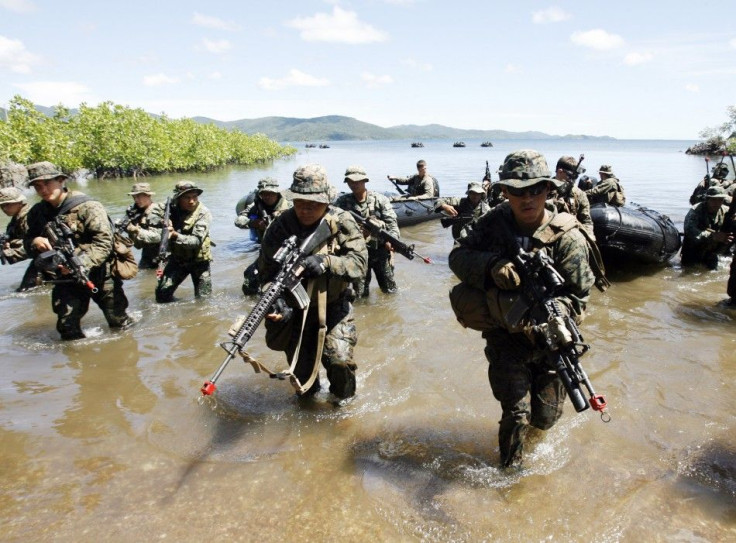South China Sea Disputes Intensify After Philippine-U.S. War Games In Palawan
ANALYSIS

The South China Sea may appear to be little more than a vast bay filled with rocky uninhabited islands. But global trade routes and underlying oil reserves have made this body of water the frontline for a tense stand-off between China, the Philippines and the United States.
The situation came to a head on Wednesday when American and Philippine soldiers waded ashore to engage in a mock assault on the island of Palawan, a Philippine territory on the edge of the South China Sea. The two allied militaries were partnering in a routine war games exercise, and U.S. officials claim their presence there has nothing whatsoever to do with China.
Beijing, which claims historical rights to almost all of the South China Sea and its rocky islands, would prefer that the United States remove itself from the region entirely.
A Sea Divided
China and the Philippines have long disputed several territories in the South China Sea; so have Taiwan, Vietnam, Malaysia and others. Claims of ownership overlap, making it difficult to keep track of just who owns what. And as the tides ebb and flow, many shoals are alternatively submerged and exposed; disputed islands frequently disappear for hours at a time, complicating each country's efforts to clearly demarcate their territories.
In other words, a maritime map of the South China Sea, including all surrounding countries' territorial claims, would be endlessly complicated. At stake in these disputes are rights to the abundant resources under the water -- oil, gas and minerals- -- as well as fishing and navigational rights.
South China Sea disputes have escalated in recent years due increased posturing from China.
Ernest Bower, director of the Southeast Asia Program at the Center for Strategic and International Studies, told CNN that China has massed considerable economic power over the last few years. It believes it has the leverage now, and it's testing it. He pointed out that over the last three years, there have been 23 confrontations over the area.
One of those incidents occurred earlier this month. On April 10, a Philippine warship set out to deter Chinese commercial vessels from fishing near the Scarborough shoal, a ring of islands claimed by both China and the Philippines. Chinese surveillance ships rushed in to defend the fishermen, leading to a tense showdown as the fishermen slipped away.
Beijing accused the Philippines of harassing the Chinese fishermen, but Philippine Defense Secretary Voltaire Gazmin responded: How can an ant bully an elephant?
Western Interests
In this ongoing conflict, the United States sides with the ants.
China hopes to deal with its Southeast Asian conflicts through bilateral negotiations--one nation at a time--but the nations in question prefer multilateral talks in order to bolster their shared position against Chinese territorial claims. The United States supports this position, and China resents the Western interference.
U.S. Secretary of State Hillary Clinton got an icy reaction from China at a forum in Manila last autumn, when she suggested that all nations should work together for a fair resolution to South China Sea conflicts. [A]ny nation with a claim has a right to assert it, she said. But they do not have a right to pursue it through intimidation or coercion.
Chinese officials responded with disdain.
Introducing a contentious subject into the meeting would only affect the atmosphere of cooperation and mutual trust, damaging the hard-won setting of healthy development in the region, said Chinese Foreign Ministry Spokesman Liu Weimin.
This year's annual war games in Palawan come ahead of a meeting between Philippine and U.S. foreign defense ministers in Washington, D.C., scheduled for next week. South China Sea disputes and defense of the Philippines will be discussed, but Chinese officials warn that these issues are beyond the purview of the United States.
The South China Sea issue is not an issue between China and the U.S., because the U.S. doesn't have claims over the South China Sea and does not take sides, said Chinese Deputy Foreign Minister Cui Tiankai.
Fuel to the Fire
Of course, the U.S. presence in the region is about more than protecting underdogs. Major U.S. oil companies including Shell, Chevron and Murphy operate in the South China Sea. So too does Philex Petroleum of the Philippines. Keen to protect these shared economic interests from Chinese aggressions, the United States has allied with the Philippines and other small Southeast Asian nations whose navies cannot stand up to China on their own.
The stakes are high; CNN reports that oil reserves in the South China Sea could contain up to as much as 213 billion barrels, in addition to a potential 3.8 trillion cubic meters of gas deposits. That would be enough energy to power all of China for decades.
Though tension between China, the Philippines and other Southeast Asian nations is not abating, actual military engagement looks highly unlikely anytime soon. Still, the South China Sea disputes will continue to drive a diplomatic wedge between U.S. and Chinese interests.
© Copyright IBTimes 2024. All rights reserved.






















